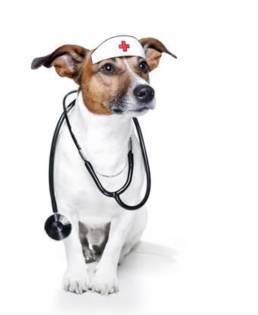Plastic Surgery for Dogs: It’s Not Just Cosmetic
July 11, 2018 • Trends • Health & Wellness
As plastic surgery for pets gains popularity, controversy surrounding the ethics of putting one’s animal under the knife grows along with it.
While plastic surgery is typically associated with cosmetic enhancement to compliment the physical aesthetics of humans, in many instances certain procedures are required strictly to improve the health, happiness and longevity of patients. In other words, plastic surgery is often a medical necessity, not strictly a cosmetic indulgence. The same thing goes for pets -- although with animals these procedures are almost always conducted for medical reasons, arguably as they should be.
Breed-specific issues
Many prospective pet owners set their hearts on a particular breed without conducting enough research into the types of health issues they may be predisposed to and/or develop throughout their lives. These usually well-meaning people are so wrapped up in the idea of becoming dog parents that they overlook the degree of maintenance and care, not to mention financial responsibility, they’re signing up for upon adopting an animal. Skin conditions, eye infections, and breathing issues are common breed-specific problems your dog may encounter over the course of its lifetime.
These issues frequently pop up with Bulldogs, Shar-Peis, and other wrinkle-skinned or brachycephalic, short-nosed dogs. Many of these creatures would benefit enormously from corrective measures like facelifts, eye lifts, or rhinoplasty, depending on their breed. Not only do these procedures relieve them of the discomfort inherent to their respective breeds, but of the health risks that accompany these predispositions.
One of the more common procedures performed on dogs with excessive amounts of facial skin is called entropion surgery. This procedure essentially lifts a dog’s eyelids, giving them better sight. It also cuts down on infections caused by bacterial growth in the folds of the skin, and reduces the frequency of corneal scratches caused by the eyelid rolling inward toward the eye.
Dog breeds with excessively wrinkled or loose skin benefit from corrective surgeries like facelifts and tummy tucks. Skin folds trap moisture, bacteria, and yeast, which in turn can lead to painful infections. This most commonly occurs with Bulldogs and Shar-Peis, but also with dogs who lose excessive amounts of weight and are left with loose skin in and around their undercarriage. It’s important to speak to your vet about the amount of recovery time your dog will require post-op, as with either surgery it can be rather extensive, largely depending on the location and amount of skin removed.
Brachycephalic syndrome is another example of a predisposed veterinary health issue commonly treated with corrective surgery. It occurs in dogs with shorter noses, like bulldogs and pugs. The problem is the length of these dog’s muzzles are too short for the length of the roof of their mouths. This blocks the trachea, which causes snoring as well as breathing issues should the dog be overheated, overweight, or excited. The dog’s respiration is inhibited because of the physical structure of their muzzle.
To correct these issues, veterinarians perform a nasal wedge resection, which is effectively a nose job for your dog. During this procedure, small wedges are removed from the black portion of the nostrils, enabling the nasal passages to open wider so the dog is able breathe with ease.
Cosmetic concerns
Of course, not all plastic surgery for canines is performed for medical reasons. Some owners are opting for surgery purely for cosmetic reasons. For example, silicone testicle implants are becoming popular with owners who have had their dogs neutered. Neuticles come in sizes suitable for dogs ranging from Chihuahuas to Great Danes. They are slipped in while your dog is being neutered, so no additional surgical procedures are necessary.
While these implants aren’t medically necessary for a dog’s health, some owners believe they improve their dog’s self-image. In reality, any difference a procedure like this could possibly make should be considered far more for the owner than for the dog itself.
Although it could be argued that the way we view our pets affects how we relate to them, and by extension a strong owner-dog bond suggests we might provide them with more affection and other forms of positive attention.
Ear cropping and tail docking are still common practices, but the number of veterinarians willing to perform these procedures is rapidly diminishing due to the questionable ethics involved. Other cosmetic options include Botox injections to clean up a dog’s facial features, tummy tucks for overweight dogs, and breast reductions for dogs that have sagging mammary glands due to over-breeding.
Canine surgery isn’t cheap, but many people (of means) are willing to pay for it. Unless deemed medically necessary, few pet insurance plans will cover plastic surgery. Even when it is considered to be a medically necessity, some plans only cover a small portion of the costs. Procedures range anywhere from $200 to $500 for eye lift surgery, and well into the thousands for more complicated procedures.
Risks and side effects
There are always risks to consider when thinking about plastic surgery for your dog. Anytime anesthesia is used, there is the possibility of an allergic reaction that could lead to swelling, difficulty breathing or anaphylaxis. Other issues that could arise include excessive bleeding, infection, and a slow recovery rate. Also, your dog will need to undergo a full check-up before going forward to ensure they are healthy enough to withstand the physical stress of going under the knife.
Other serious considerations should include the emotional toll and potential discomfort your pet may experience from any of these procedures. Dogs obviously aren’t able to vocalize the way we can and thus may be in greater pain than their owners are able to see.
Finally, remember that there will be a recuperation period for your dog after surgery. This often involves regular doses of oral medications for both pain and infection prevention, the application of topical medications, the use of an e-collar to restrict your dog’s access to the surgical site, and the limitation of exercise and activities until your dog fully heals.
As such, these aren’t decisions to be made lightly. And should you choose to go ahead with it, make sure that you’ll have the time to devote to your dog’s post-op needs. Ideally, plan your dog’s surgery when you have some vacation time coming up, or arrange for a friend or family member to keep an eye on your dog while you’re at work.
.jpg)







